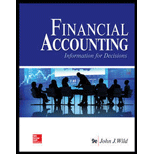
1.
Concept Introduction:
Accounting has formula that represents assets is equal to the liabilities plus owner’s equity. Each year owner’s equity is calculated by after reducing and adding the profit or loss of the year. Net Income or profit is calculated by reducing expenses from revenues.
To Calculate: Total Amount of assets invested in the business.
2.
Concept Introduction:
Accounting has a formula that represents assets is equal to the liabilities plus owner’s equity. Each year owner’s equity is calculated by after reducing and adding the profit or loss of the year. Net Income or profit is calculated by reducing expenses from revenues.
To Calculate: Return on assets for current year.
3.
Concept Introduction:
Accounting has a formula that represents assets is equal to the liabilities plus owner’s equity. Each year owner’s equity is calculated by after reducing and adding the profit or loss of the year. Net Income or profit is calculated by reducing expenses from revenues.
To Calculate: Total expenses incurred in current year.
4.
Concept Introduction:
Accounting has a formula that represents assets is equal to the liabilities plus owner’s equity. Each year owner’s equity is calculated by after reducing and adding the profit or loss of the year. Net Income or profit is calculated by reducing expenses from revenues.
To Calculate: Current year return is worse or better than other companies.
Want to see the full answer?
Check out a sample textbook solution
Chapter 1 Solutions
Loose Leaf for Financial Accounting: Information for Decisions
- Calculate Jenkins' net sales for the period.arrow_forwardNeed solution. General accountingarrow_forwardTownsend Manufacturing has a predetermined overhead rate of $5 per machine hour. Last year, the company incurred $128,700 of actual manufacturing overhead cost, and the account was $4,500 over-applied. How many machine hours were used during the year?arrow_forward
- For the past 10 years, Prince Company (Prince) has owned 75,000 or 75% of the common shares of Stiff Inc. (Stiff). Elizabeth Winer owns another 20% and the other 5% are widely held. Although Prince has the controlling interest, you would never know it during the annual shareholders’ meetings. Winer keeps the board of directors on its toes by asking a lot of tough questions and continually threatening legal action if her rights as a minority shareholder are not protected. Rick Impatient owns 100% of the shares of Prince. After Prince’s latest shareholders’ meeting, he decided that Prince would offer to purchase Winer’s shares in Stiff or Prince would sell its interest in Stiff because Impatient is tired of all of the heckling from Winer. The shares of Stiff were recently trading for $50 per share. On November 13, Year 13, Prince offered to pay $54 per share to Winer for her 20% interest in Stiff. To Impatient’s surprise, Winer accepted the offer and the transaction was consummated on…arrow_forwardWhat is the amount of interest expense on July 1?arrow_forwardRedmond Industries bases its predetermined overhead rate on the estimated machine-hours for the upcoming year. Data for the most recently completed year appear below: • • Estimated machine-hours = 21,500 Estimated variable manufacturing overhead = $8.25 per machine-hour Estimated total fixed manufacturing overhead $495,000 Actual machine-hours for the year = 22,800 = What is the predetermined overhead rate for the recently completed year?arrow_forward
 Financial AccountingAccountingISBN:9781337272124Author:Carl Warren, James M. Reeve, Jonathan DuchacPublisher:Cengage Learning
Financial AccountingAccountingISBN:9781337272124Author:Carl Warren, James M. Reeve, Jonathan DuchacPublisher:Cengage Learning Managerial AccountingAccountingISBN:9781337912020Author:Carl Warren, Ph.d. Cma William B. TaylerPublisher:South-Western College Pub
Managerial AccountingAccountingISBN:9781337912020Author:Carl Warren, Ph.d. Cma William B. TaylerPublisher:South-Western College Pub Financial AccountingAccountingISBN:9781305088436Author:Carl Warren, Jim Reeve, Jonathan DuchacPublisher:Cengage Learning
Financial AccountingAccountingISBN:9781305088436Author:Carl Warren, Jim Reeve, Jonathan DuchacPublisher:Cengage Learning





